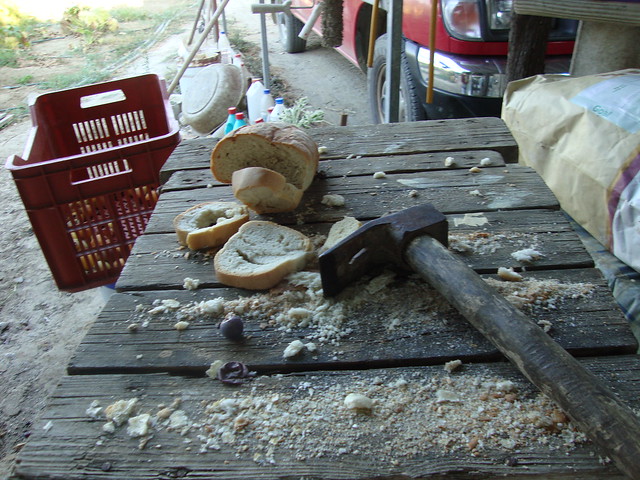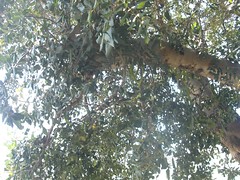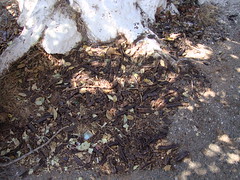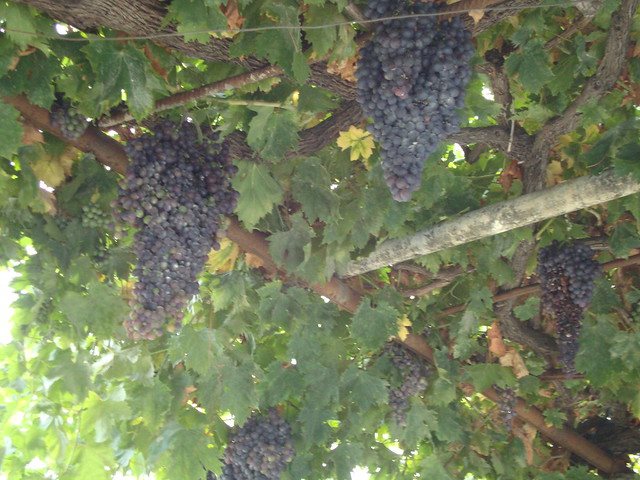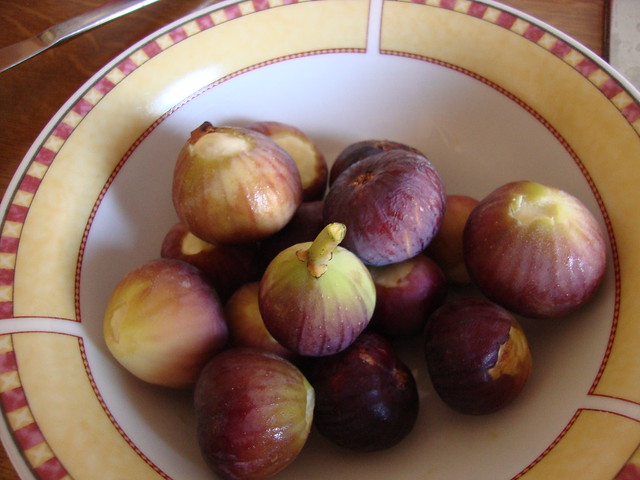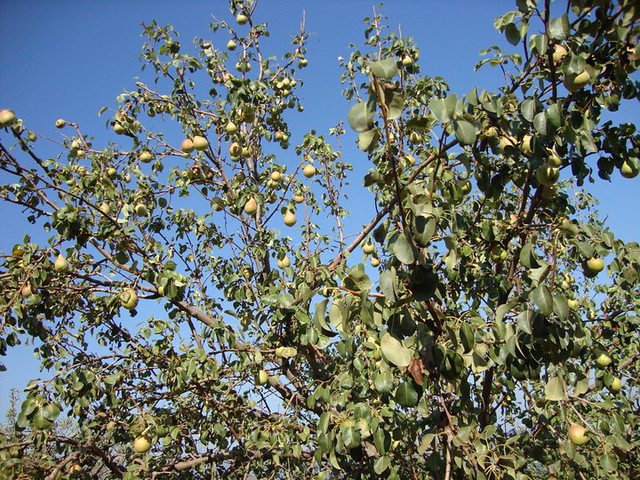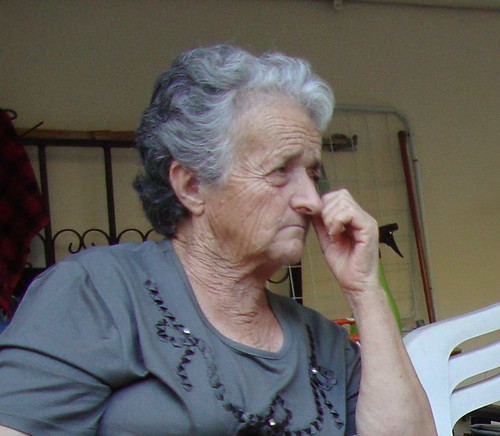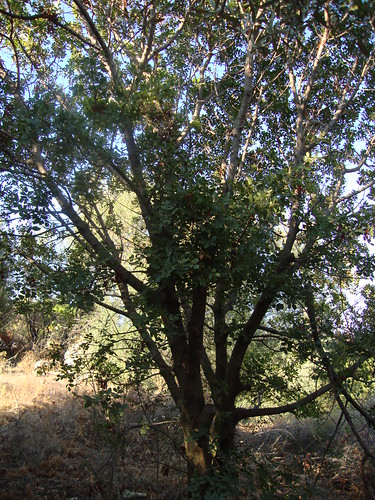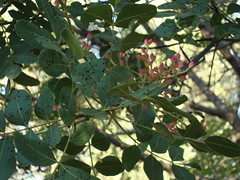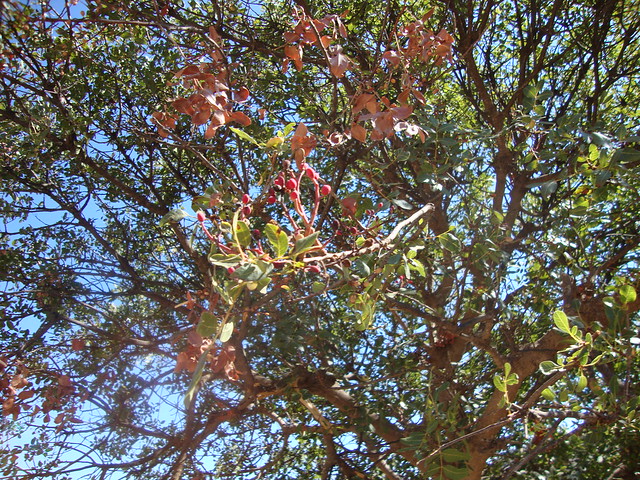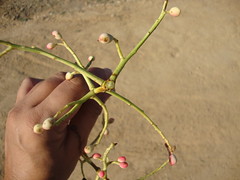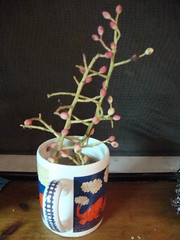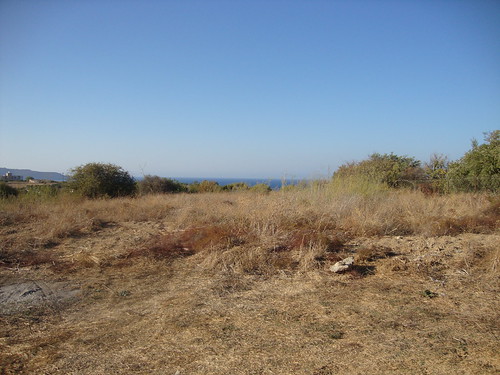My household is a great consumer of honey. When I think of the amount of honey we get through in a year, even I am amazed - we buy about 15-20 kilograms of honey every year, which is consumed among the 5 of us. Yes! 15-20 kg per year! Is this too much? I don't know what to say... I just know that we do in fact get through that much and it feels about as normal as going through 150 kg of olive oil per year (again, among the 5 of us). What's more, I rarely (if ever) use honey in my cooking - honey is used in very limited ways in my household's food preparation:

All the honey we consume comes from one source: I have a cousin who is a beekeeper. He refills my jars year after year. He keeps beehives in forested area in Sfakia, and produces fresh honey in the summer. So it is fair to call honey a seasonal product. Cretan honey is said to be among the best in the world. But like any overly good product, it can also be prone to fraud. At the same time, it is almost impossible to tell at first glance whether a honey variety is very good or not - colour, smell, density and crystallisation do not indicate this. Beekeepers may also feed their bees sugar in the colder months of the year or when there is a lack of flora, which is 'against' international rules for honey production. But we can't ever know this - such information can only be obtained by a laboratory analysis.
 During a recent trip to London, a friend presented me with some honey that he had helped to produce. Apparently bees find London a better place to produce honey than other parts of England because London is where more flowers are grown, at least this is what we were told. The honey we were presented with certainly did look and taste different to our regular Cretan supplies. For a start, it was very runny (ours is very dense), it smelt of mint (ours smelt of thyme), it had a very clear colour (ours is quite dark), and we were told it was prone to natural cystalisation, which we found quite interesting, because we've never seen honey crystallise in our house (it gets eaten too quickly).
During a recent trip to London, a friend presented me with some honey that he had helped to produce. Apparently bees find London a better place to produce honey than other parts of England because London is where more flowers are grown, at least this is what we were told. The honey we were presented with certainly did look and taste different to our regular Cretan supplies. For a start, it was very runny (ours is very dense), it smelt of mint (ours smelt of thyme), it had a very clear colour (ours is quite dark), and we were told it was prone to natural cystalisation, which we found quite interesting, because we've never seen honey crystallise in our house (it gets eaten too quickly).

The honey came from Brockwell Park, where there are community gardens and a group of beekeepers who strive to produce fresh natural produce in a city where most food is imported into the general area. Apart from honey, my friend also collects beeswax and makes candles, and he is also learning to make mead. My friend also showed us some older honey, which had crystalised, so that it looked like butter in a jar. It's still good honey, he reassured us, which we found amusing, because he still hadn't opened the jar, which contained only a quarter of the amount that are own jars usually contain!
 He also showed us a large plastic tub of honey which he explained was not good for eating because it contained too much moisture and tiny droplets of wax. In fact, it did taste a little waxy to us, and it was not very sweet, mainly due to the excess moisture content, we were told. He intended to use it to make mead - this supposedly sub-standard honey could be used as an ingredient, he told us, but it could not be sold as fresh honey. He also gave us some buttery looking manuka honey to try, which as a beekeeper, he thought he should try. As there was no other honey in his house where we were staying, except the buttery honey varieties, we preferred to use the waxy sub-standard honey which was still runny. I used it to make a pear pie with pears I had bought from Crete, and a cheese pie using mizithra I had also bought along with me. In both cases, I used this waxy honey in the batter as well as a topping. We liked the results very much.
He also showed us a large plastic tub of honey which he explained was not good for eating because it contained too much moisture and tiny droplets of wax. In fact, it did taste a little waxy to us, and it was not very sweet, mainly due to the excess moisture content, we were told. He intended to use it to make mead - this supposedly sub-standard honey could be used as an ingredient, he told us, but it could not be sold as fresh honey. He also gave us some buttery looking manuka honey to try, which as a beekeeper, he thought he should try. As there was no other honey in his house where we were staying, except the buttery honey varieties, we preferred to use the waxy sub-standard honey which was still runny. I used it to make a pear pie with pears I had bought from Crete, and a cheese pie using mizithra I had also bought along with me. In both cases, I used this waxy honey in the batter as well as a topping. We liked the results very much.


My friend also gave us some Brockwell Park honey to take home with us as a present. When I went to the store room to place it together with our honey jars, I was surprised to find a jar of Cretan honey lurking in a dark corner of the shelf, which I had not used in due time. It wasn't runny, and it hadn't lost its colour or its texture, but I could tell that this honey had undergone some transformation form its taste - it did not taste sweet and it seemed to lack the thyme aroma that I was used to. That's when I got the idea to take some samples of each honey type - fresh London honey (FL), old Cretan honey (OC), fresh Cretan honey (FC) - into the MAICh laboratories at work to have them checked.

Honey is influenced by very many factors: the flower species, temperature, environmental conditions, age and storage conditions are just a few things that make or break a good honey variety. The floral species used in the honey give honey its colour and aroma, as well as its texture. Crystallisation is also a feature in honey of certain floral species (eg citrus). Honey is like olive oil - their properties undergo a negative change as they age. So honey is not like wine, whose taste could improve with age. Apiculturalists check for moisture content, diastase activity and hydroxy-methyl-furfural (HMF) content.
Water content crystallises honey more quickly, which explains why the London honey crystallised whereas the Cretan honey didn't. The environmental conditions of London are damper than in Crete. This in fact was proven in the laboratory analyses: of the three samples, FL contained the highest moisture levels (17.6, while the two Cretan samples (OC and FC) contained the same moisture content (14.3-14.6). But FL was still within the limits set by international regulations, which state that moisture content in honey must be less than 20.
Diastase activity tells us whether the honey has been subjected to high temperature, which makes it runnier. This is a trick that honey sellers may use if their honey crystalises. Honey production does involve heating but only at appropriate temperatures. Diastase activity is lower in honey that have been subjected to very high temperatures. Of my three honey samples, LH had the highest diastate activity (19.9) while FC had 13.8. Both honey were within international limits, which state that diastate acitivity must be higher than 8. But OC was not within the limit: it had a diastase activity of just 6.7. Since I know my honey source well, and both OC and FC come from the same source, what could have gone wrong? Most likely, the storage conditions of OC were inappropriate: I had left the honey in a space which gets overheated in summer, whcih most likely affected it, since I had forgotten it there for over a year, something I rarely do with honey, given our high consumption levels.
Finally, the HMF content also tells us about whether a honey variety has been heated inappropriately. This should be lower than 40, and all my honey samples fell well within the limit - FL: 3.4, OC: 5.8 and FC: 3. So I am able to conclude that the storage conditions for OC were what reduced the quality of my old Cretan honey sample.
OC: Eucalyptus camaldulensis (40%), with 3-15% traces of thyme (Thymbra capitata) (14%), dandelion (Taraxacum sp.), heather (Erica sp.), Trifolium repens type, sporadic traces of Cirsium type, Urginea maritima, Parthenocissus sp., Satureja thymbra, Citrus sp., avocado tree (Persea americana), Brassicaceae, and pollen grains of nectarless plants: Verbascum sp., Olea sp., Cistaceae, Graminae, Hypericum sp., Vitis vinifera, Ephedra sp.
FC: Chestnut tree (Castanea sativa) (32%), with 3-15% traces of thyme (Thymbra capitata) (12%), heather (Erica sp.), Trifolium repens type, myrtle (Myrtus communis), Eucalyptus sp., Satureja thymbra, sporadic traces of dandelion (Taraxacum sp.), Cirsium type, Apiaceae, Urginea maritima, Oxalis pes-caprae, Centaurea solstitialis type, Parthenocissus sp.and pollen grains of nectarless plants: Verbascum sp., Olea sp., Hypericum sp., Cistaceae, Pistacia lentiscus.
Based on the pollen examination, the London honey was classified as multi-floral while the Cretan samples were honey blends because they contained honeydew elements from pine trees, whereas the London honey contained no honeydew. This tells us a little about the insects that survive in the general area where the honey is produced. Honeydew, a honey blend of flower nectar and pine honeydew, also gives the darker colour of Cretan honey, which is highly prized in for its reputed medicinal value: in Greek mythology, méli, "honey", drips from the Manna–ash, (Fraxinus ornus), with which the Meliae, or "ash tree nymphs", nursed the infant god Zeus on the island of Crete.
However, the diastase activity of OC was below the honey legislation limit, so that particular honey sample can only be characterized as 'baker's honey'. Although I don't use honey in my baking, I am now using this honey in my cake batters and syrup making, instead of sugar to use it up without wasting it. Even my friend's high-moisture waxy London honey was still edible - it just wasn't marketable. Another interesting point is that the famous thyme honey of Crete can only be called 'thyme honey' when the thyme pollent content is at least 18%. Therefore, my thyme honey samples, while smelling unmistakably of thyme, cannot be called thyme honeys in the market sense because they contained only 14.6% (OC) and 13.4% (FH) thyme pollen.
I passed on the tests to my London friend who took them to his apiculturalist's club, who were very pleased to get them. Such tests are not available to small producers in London, mainly due to the cots involved. They were very pleased to read that their honey was of the highest quality that could be produced anywhere in their country. As for my own honey samples, I couldn't have been more pleased - and next time, I'll be more careful of where I store my honey jars.
Many thanks to Slim Blidi, whose thesis on the topic of "Effect of thermal treatment on the quality of Cretan honeys" I had the pleasure to read, whcih helped me to better understand the magic of honey, and enabled me to write this post.
©All Rights Reserved/Organically cooked. No part of this blog may be reproduced and/or copied by any means without prior consent from Maria Verivaki.
- a teaspoon in tea or milky coffee
- as a spread on bread and butter
- a tablespoon poured over each individual sfakiani pita, a traditional Cretan dessert
- a couple of tablespoons slathered on top of pan-fried cheese-based kalitsounia, another traditional Cretan dessert (occasionally, mainly when I'm in the mood to make them)
- making syrup (for Greek-style syrup desserts, eg karidopita, galaktoboureko - very occasionally, mainly for a party)
- as a yoghurt topping
Lately, I've also used it in some savoury meals like fried chicken wings, and I've also tried it in biscuit batters. But generally speaking, we consume honey as a raw product, and rarely as an ingredient in our family recipes.

All the honey we consume comes from one source: I have a cousin who is a beekeeper. He refills my jars year after year. He keeps beehives in forested area in Sfakia, and produces fresh honey in the summer. So it is fair to call honey a seasonal product. Cretan honey is said to be among the best in the world. But like any overly good product, it can also be prone to fraud. At the same time, it is almost impossible to tell at first glance whether a honey variety is very good or not - colour, smell, density and crystallisation do not indicate this. Beekeepers may also feed their bees sugar in the colder months of the year or when there is a lack of flora, which is 'against' international rules for honey production. But we can't ever know this - such information can only be obtained by a laboratory analysis.
 During a recent trip to London, a friend presented me with some honey that he had helped to produce. Apparently bees find London a better place to produce honey than other parts of England because London is where more flowers are grown, at least this is what we were told. The honey we were presented with certainly did look and taste different to our regular Cretan supplies. For a start, it was very runny (ours is very dense), it smelt of mint (ours smelt of thyme), it had a very clear colour (ours is quite dark), and we were told it was prone to natural cystalisation, which we found quite interesting, because we've never seen honey crystallise in our house (it gets eaten too quickly).
During a recent trip to London, a friend presented me with some honey that he had helped to produce. Apparently bees find London a better place to produce honey than other parts of England because London is where more flowers are grown, at least this is what we were told. The honey we were presented with certainly did look and taste different to our regular Cretan supplies. For a start, it was very runny (ours is very dense), it smelt of mint (ours smelt of thyme), it had a very clear colour (ours is quite dark), and we were told it was prone to natural cystalisation, which we found quite interesting, because we've never seen honey crystallise in our house (it gets eaten too quickly).
The honey came from Brockwell Park, where there are community gardens and a group of beekeepers who strive to produce fresh natural produce in a city where most food is imported into the general area. Apart from honey, my friend also collects beeswax and makes candles, and he is also learning to make mead. My friend also showed us some older honey, which had crystalised, so that it looked like butter in a jar. It's still good honey, he reassured us, which we found amusing, because he still hadn't opened the jar, which contained only a quarter of the amount that are own jars usually contain!
 He also showed us a large plastic tub of honey which he explained was not good for eating because it contained too much moisture and tiny droplets of wax. In fact, it did taste a little waxy to us, and it was not very sweet, mainly due to the excess moisture content, we were told. He intended to use it to make mead - this supposedly sub-standard honey could be used as an ingredient, he told us, but it could not be sold as fresh honey. He also gave us some buttery looking manuka honey to try, which as a beekeeper, he thought he should try. As there was no other honey in his house where we were staying, except the buttery honey varieties, we preferred to use the waxy sub-standard honey which was still runny. I used it to make a pear pie with pears I had bought from Crete, and a cheese pie using mizithra I had also bought along with me. In both cases, I used this waxy honey in the batter as well as a topping. We liked the results very much.
He also showed us a large plastic tub of honey which he explained was not good for eating because it contained too much moisture and tiny droplets of wax. In fact, it did taste a little waxy to us, and it was not very sweet, mainly due to the excess moisture content, we were told. He intended to use it to make mead - this supposedly sub-standard honey could be used as an ingredient, he told us, but it could not be sold as fresh honey. He also gave us some buttery looking manuka honey to try, which as a beekeeper, he thought he should try. As there was no other honey in his house where we were staying, except the buttery honey varieties, we preferred to use the waxy sub-standard honey which was still runny. I used it to make a pear pie with pears I had bought from Crete, and a cheese pie using mizithra I had also bought along with me. In both cases, I used this waxy honey in the batter as well as a topping. We liked the results very much. 

My friend also gave us some Brockwell Park honey to take home with us as a present. When I went to the store room to place it together with our honey jars, I was surprised to find a jar of Cretan honey lurking in a dark corner of the shelf, which I had not used in due time. It wasn't runny, and it hadn't lost its colour or its texture, but I could tell that this honey had undergone some transformation form its taste - it did not taste sweet and it seemed to lack the thyme aroma that I was used to. That's when I got the idea to take some samples of each honey type - fresh London honey (FL), old Cretan honey (OC), fresh Cretan honey (FC) - into the MAICh laboratories at work to have them checked.

Honey is influenced by very many factors: the flower species, temperature, environmental conditions, age and storage conditions are just a few things that make or break a good honey variety. The floral species used in the honey give honey its colour and aroma, as well as its texture. Crystallisation is also a feature in honey of certain floral species (eg citrus). Honey is like olive oil - their properties undergo a negative change as they age. So honey is not like wine, whose taste could improve with age. Apiculturalists check for moisture content, diastase activity and hydroxy-methyl-furfural (HMF) content.
Water content crystallises honey more quickly, which explains why the London honey crystallised whereas the Cretan honey didn't. The environmental conditions of London are damper than in Crete. This in fact was proven in the laboratory analyses: of the three samples, FL contained the highest moisture levels (17.6, while the two Cretan samples (OC and FC) contained the same moisture content (14.3-14.6). But FL was still within the limits set by international regulations, which state that moisture content in honey must be less than 20.
Diastase activity tells us whether the honey has been subjected to high temperature, which makes it runnier. This is a trick that honey sellers may use if their honey crystalises. Honey production does involve heating but only at appropriate temperatures. Diastase activity is lower in honey that have been subjected to very high temperatures. Of my three honey samples, LH had the highest diastate activity (19.9) while FC had 13.8. Both honey were within international limits, which state that diastate acitivity must be higher than 8. But OC was not within the limit: it had a diastase activity of just 6.7. Since I know my honey source well, and both OC and FC come from the same source, what could have gone wrong? Most likely, the storage conditions of OC were inappropriate: I had left the honey in a space which gets overheated in summer, whcih most likely affected it, since I had forgotten it there for over a year, something I rarely do with honey, given our high consumption levels.
Finally, the HMF content also tells us about whether a honey variety has been heated inappropriately. This should be lower than 40, and all my honey samples fell well within the limit - FL: 3.4, OC: 5.8 and FC: 3. So I am able to conclude that the storage conditions for OC were what reduced the quality of my old Cretan honey sample.
The MAICh laboratory was also able to give us information on the pollen sources of each variety of honey, by checking for the frequency of pollen grains from nectar giving plants found in the honey. More importantly, the pollen information can tell us whether chemicals or artificial feeding have been used in the honey-making process. Bees travel a lot, so they are most likely picking pollen from a wide variety of sources. Here is what we found for my honey samples:
LH: Eucalyptus occidentalis type (29%), chestnut tree (Castanea sativa) (17%), with 3-15% traces of Pyrus-Prunus type (e.g. almond tree), Malus type (apple tree), Trifolium repens type, Robinia sp. (locust tree), sporadic traces of Salix sp., Brassicaceae, Centaurea sp., Boraginaceae, Liliaceae, and pollen grains of nectarless plants: Quercus sp., Graminae, Hypericum sp., Cyperaceae, Pinaceae.OC: Eucalyptus camaldulensis (40%), with 3-15% traces of thyme (Thymbra capitata) (14%), dandelion (Taraxacum sp.), heather (Erica sp.), Trifolium repens type, sporadic traces of Cirsium type, Urginea maritima, Parthenocissus sp., Satureja thymbra, Citrus sp., avocado tree (Persea americana), Brassicaceae, and pollen grains of nectarless plants: Verbascum sp., Olea sp., Cistaceae, Graminae, Hypericum sp., Vitis vinifera, Ephedra sp.
FC: Chestnut tree (Castanea sativa) (32%), with 3-15% traces of thyme (Thymbra capitata) (12%), heather (Erica sp.), Trifolium repens type, myrtle (Myrtus communis), Eucalyptus sp., Satureja thymbra, sporadic traces of dandelion (Taraxacum sp.), Cirsium type, Apiaceae, Urginea maritima, Oxalis pes-caprae, Centaurea solstitialis type, Parthenocissus sp.and pollen grains of nectarless plants: Verbascum sp., Olea sp., Hypericum sp., Cistaceae, Pistacia lentiscus.
Based on the pollen examination, the London honey was classified as multi-floral while the Cretan samples were honey blends because they contained honeydew elements from pine trees, whereas the London honey contained no honeydew. This tells us a little about the insects that survive in the general area where the honey is produced. Honeydew, a honey blend of flower nectar and pine honeydew, also gives the darker colour of Cretan honey, which is highly prized in for its reputed medicinal value: in Greek mythology, méli, "honey", drips from the Manna–ash, (Fraxinus ornus), with which the Meliae, or "ash tree nymphs", nursed the infant god Zeus on the island of Crete.
However, the diastase activity of OC was below the honey legislation limit, so that particular honey sample can only be characterized as 'baker's honey'. Although I don't use honey in my baking, I am now using this honey in my cake batters and syrup making, instead of sugar to use it up without wasting it. Even my friend's high-moisture waxy London honey was still edible - it just wasn't marketable. Another interesting point is that the famous thyme honey of Crete can only be called 'thyme honey' when the thyme pollent content is at least 18%. Therefore, my thyme honey samples, while smelling unmistakably of thyme, cannot be called thyme honeys in the market sense because they contained only 14.6% (OC) and 13.4% (FH) thyme pollen.
I passed on the tests to my London friend who took them to his apiculturalist's club, who were very pleased to get them. Such tests are not available to small producers in London, mainly due to the cots involved. They were very pleased to read that their honey was of the highest quality that could be produced anywhere in their country. As for my own honey samples, I couldn't have been more pleased - and next time, I'll be more careful of where I store my honey jars.
Many thanks to Slim Blidi, whose thesis on the topic of "Effect of thermal treatment on the quality of Cretan honeys" I had the pleasure to read, whcih helped me to better understand the magic of honey, and enabled me to write this post.
©All Rights Reserved/Organically cooked. No part of this blog may be reproduced and/or copied by any means without prior consent from Maria Verivaki.



















